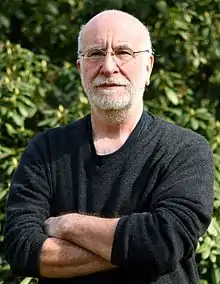Jürgen Brosius
Jürgen Brosius (* 1948 in Saarbrücken) ist ein deutscher Molekulargenetiker und Evolutionsbiologe. Er lehrt an der Westfälischen Wilhelms-Universität in Münster und leitet dort das Institut für Experimentelle Pathologie.

Leben
Jürgen Brosius forschte und lehrte unter anderem an der University of California, Santa Cruz als Postdoctoral Fellow in dem Labor von Harry Noller sowie an der Harvard University als Postdoctoral Fellow in dem Labor des Nobelpreisträgers Walter Gilbert. Von 1982 bis 1988 hatte er eine Professur an der Columbia University in Manhattan im Centre for Neurobiology & Behavior inne. Anschließend war er am Fishberg Research Center for Neurobiology der Mount Sinai School of Medicine in New York. Seit 1994 leitet er das Institut für experimentelle Pathologie der Universität Münster und forscht an RNAs, Retroposition und deren Rolle bei der Evolution von Genen und Genomen. Seit 2015 ist er auch Gastprofessor an der neu gegründeten Privatuniversität Medizinische Hochschule Brandenburg Theodor Fontane.
In Kalifornien klärte er als erster die Sequenz eines ribosomalen RNA-Operons auf[1] einschließlich der 16S rRNA und 23S rRNA, und in den 1980er Jahren begann er, die Ära der RNomics einzuläuten.[2][3][4] Auf ihn gehen auch Forschungserkenntnisse im Bereich der Konvertierung von RNA zu DNA bei gleichzeitiger Integration ins Genom (Retroposition) und deren Bedeutung für die Plastizität von Genomen zurück.[5] In Zusammenarbeit mit Stephen Jay Gould hat er eine Nomenklatur (On "genomenclature": a comprehensive (and respectful) taxonomy for pseudogenes and other "junk DNA")[6] publiziert, die für ein besseres Verständnis für die Funktion von retroposons (retronuons) und deren Bedeutung für die Rekrutierung oder Exaptation von funktionalen genomischen Modulen sorgen soll.[7][8][9][10]
Weblinks
- Institut für Experimentelle Pathologie. Zentrum für Molekularbiologie der Entzündung (ZMBE), abgerufen am 1. April 2015.
Einzelnachweise
- J. Brosius, T. J. Dull u. a.: Gene organization and primary structure of a ribosomal RNA operon from Escherichia coli. In: Journal of molecular biology. Band 148, Nummer 2, Mai 1981, S. 107–127, PMID 7028991.
- T. M. DeChiara, J. Brosius: Neural BC1 RNA: cDNA clones reveal nonrepetitive sequence content. In: Proceedings of the National Academy of Sciences. Band 84, Nummer 9, Mai 1987, S. 2624–2628, PMID 2437583, PMC 304710 (freier Volltext).
- W. Filipowicz: Imprinted expression of small nucleolar RNAs in brain: time for RNomics. In: Proceedings of the National Academy of Sciences. Band 97, Nummer 26, Dezember 2000, S. 14035–14037, doi:10.1073/pnas.97.26.14035, PMID 11121012, PMC 34092 (freier Volltext) (Review).
- A. Hüttenhofer, M. Kiefmann u. a.: RNomics: an experimental approach that identifies 201 candidates for novel, small, non-messenger RNAs in mouse. In: The EMBO Journal. Band 20, Nummer 11, Juni 2001, S. 2943–2953, doi:10.1093/emboj/20.11.2943, PMID 11387227, PMC 125495 (freier Volltext).
- J. Brosius: Retroposons–seeds of evolution. In: Science. Band 251, Nummer 4995, Februar 1991, S. 753, PMID 1990437 (Review).
- J. Brosius, S. J. Gould: On "genomenclature": a comprehensive (and respectful) taxonomy for pseudogenes and other "junk DNA". In: Proceedings of the National Academy of Sciences. Band 89, Nummer 22, November 1992, S. 10706–10710, PMID 1279691, PMC 50410 (freier Volltext).
- J. Brosius: RNAs from all categories generate retrosequences that may be exapted as novel genes or regulatory elements. In: Gene. 238, 1999, S. 115–134, doi:10.1016/S0378-1119(99)00227-9.
- J. Brosius: The fragmented gene. In: Annals of the New York Academy of Sciences. Band 1178, Oktober 2009, S. 186–193, doi:10.1111/j.1749-6632.2009.05004.x, PMID 19845638 (Review).
- J. Brosius: The persistent contributions of RNA to eukaryotic gen(om)e architecture and cellular function. In: Cold Spring Harbor perspectives in biology. Band 6, Nummer 12, Juli 2014, S. a016089, doi:10.1101/cshperspect.a016089, PMID 25081515, PMC 4292154 (freier Volltext) (Review).
- genome.cshlp.org